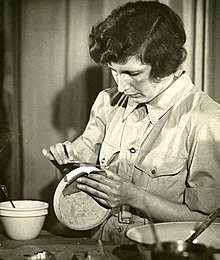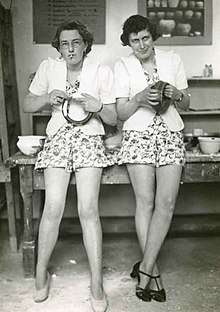Ione Gedye
Ione Gladys Gedye[1] (1907-1990) was a pioneer conservator who founded the Repair Department at the Institute of Archaeology. She worked for over several decades in conservation at the Institute and was also a significant influence in the early years of archaeologically-themed television programmes.[2]
Ione Gedye | |
|---|---|
 | |
| Born | 1907 |
| Died | 1990 |
| Education | University College London |
| Occupation | Conservator |
| Years active | 1937-1975 |
| Employer | University College London |
| Organization | Institute of Archaeology |
| Known for | Founding the conservation department at the Institute of Archaeology |
Education
Ione Gedye attended Francis Holland School, Graham Terrace between 1918 and 1925.
Gedye was a student of Flinders Petrie, and studied classical archaeology at University College, London.[3] She volunteered to clean items from one of Petrie's excavations for a summer exhibition.[4]
Gedye worked at the Verulamium excavations with Tessa Verney Wheeler and Kathleen Kenyon. Wheeler had her clean metalwork from the excavations and encouraged her interest in artefacts.[5]
Whilst studying at the University of London, Gedye also rowed for her university on the same team as Eleanor Gait.[6]
Career

Gedye was one of the original staff members in the technical department at the Institute of Archaeology, which opened in 1937. She was the founder of the Repair Department, which was initially housed in a former operating theatre.[4]
There was no formal training programme in conservation in the 1930s, and Gedye conducted experiments to inform her work.[7] She also learned about restoring and cleaning artefacts from people such as Harold Plenderleith at the British Museum Research Laboratory and from staff at the Royal Museums of Art and History in Brussels.[8]
During the war, she worked on reconstructions of Pleistocene mammals.[9]
Gedye taught conservation from 1937 to 1975.[10] After World War II, she headed a conservation course that became increasingly attractive to students, and gradually expanded from a one-year certificate to become a three-year degree course.[11] In the late 1950s, Gedye was joined in her work by Henry W. M. Hodges who helped her to develop the training course.[12] Early broadcasts of archaeological digs by the BBC were informed by Gedye's work, as well as that of Margot Eates and Delia Parker.[13] This work educated the public and contributed to the professionalisation of archaeology in the UK.
Gedye retired in July 1975.[4]
Death and legacy
Gedye died in 1990.
The UCL Institute of Archaeology awards an Ione Gedye Award each year for the best conservation-based dissertation.[14] This prize was created when Gedye requested that her colleagues create a prize for students rather than buy her a retirement gift.
Gedye's portrait hangs in the Institute.[15]
References
- A Short History of IIC: Foundation and Development, Hero Boothroyd Brooks, International Institute for Conservation of Historic and Artistic Works, 2000, p. 42
- Perry, Sara (2017-01-02). "Archaeology on Television, 1937" (PDF). Public Archaeology. 16 (1): 3–18. doi:10.1080/14655187.2017.1283932. ISSN 1465-5187.
- The Calendar for the year 1931-1932, University of London, pp. 299, 502
- Pye, Elizabeth; Brommelle, Norman (January 1977). "A Tribute to Ione Gedye". The Conservator. 1 (1): 3–4. doi:10.1080/01400096.1977.9635631. ISSN 0140-0096.
- Pye, Elizabeth (2015-11-16). "From the Archives: Women of the Early Institute". Archaeology International. 18: 131–133. doi:10.5334/ai.1817. ISSN 2048-4194.
- Lester, Tim (26 April 2011). "Gait, Eleanor". River & Rowing Museum. Retrieved 2019-11-15.
- Clavir, Miriam (March 2012). Preserving What Is Valued. UBC Press. p. 6. ISBN 9780774852500.
- Johnson, Jessica S. (1993). "Conservation and Archaeology in Great Britain and the United States: A Comparison". cool.conservation-us.org. Retrieved 2019-11-14.
- Alberti, Benjamin; Jones, Andrew Meirion; Pollard, Joshua (2016-06-16). Archaeology After Interpretation: Returning Materials to Archaeological Theory. Routledge. p. 290. ISBN 9781315434247.
- O’Grady, Caitlin R. (12 June 2017). "Sticking, mending and restoring: the conservator's role in archaeology". Filming Antiquity. UCL. Retrieved 2019-11-14.
- "Conservation and Heritage Management Award". Archaeological Institute of America. 1998. Retrieved 2019-11-15.
- Pye, Elizabeth (17 June 1997). "Obituary: Professor H. W. M. Hodges". The Independent. Retrieved 2019-11-15.
- Mizoguchi, Koji; Smith, Claire E. (2019-06-27). Global Social Archaeologies: Making a Difference in a World of Strangers. Routledge. ISBN 9781000596755.
- "Awarded MA in Principles of Conservation by UCL". Times of Malta. Retrieved 2019-11-14.
- Thornton, Amara (21 August 2016). "Archaeological Portraits". Reading Room Notes. Retrieved 2019-11-14.